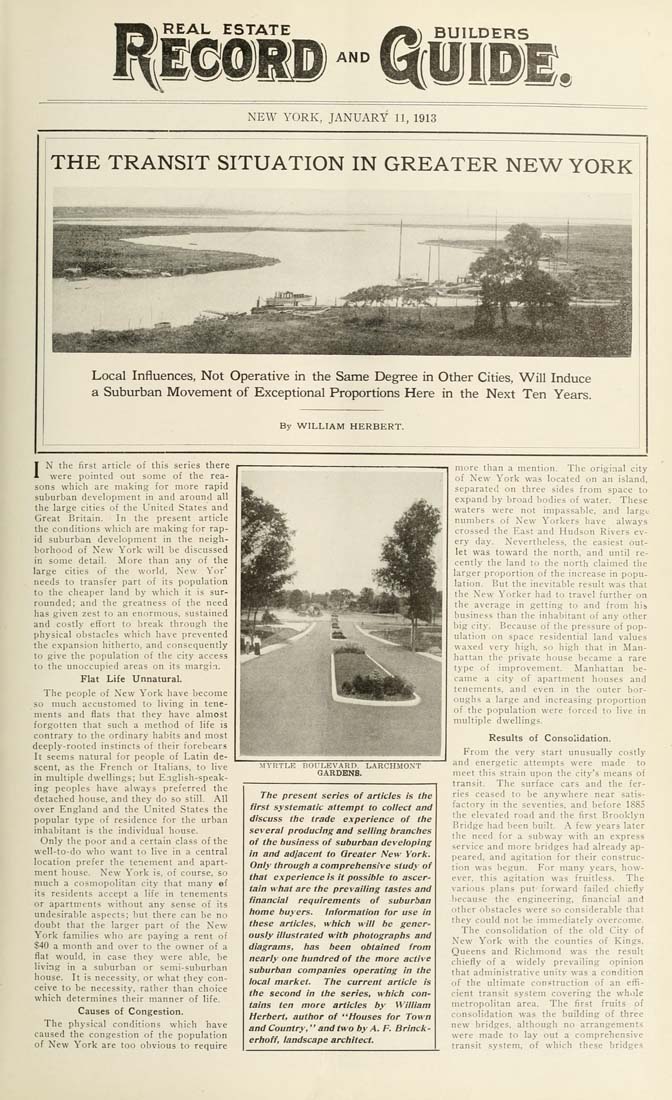Columbia University Libraries Digital Collections: The Real Estate Record
Use your browser's Print function to print these pages.
Real estate record and builders' guide: [v. 91, no. 2339]: January 11, 1913

Text version:
Please note: this text may be incomplete. For more information about this OCR, view About OCR text.
BUILDERS AND NEW YORK, JANUARY 11, 1913 THE TRANSIT SITUATION IN GREATER NEW YORK Local Influences, Not Operative in the Same Degree in Other Cities, Will Induce a Suburban Movement of Exceptional Proportions Here in the Next Ten Years. By WILLIAM HERBERT. IN the first article of this series there were pointed out some of the rea¬ sons which are making for more rapid suburban development in and around all the large cities of the United States and Great Britain. In the present article the conditions which are making for rap¬ id suburban development in the neigh¬ borhood of New York will be discussed in some detail. More than any of the large cities of the world. New Yor' needs to transfer part of its population to the cheaper land by which it is sur¬ rounded; and the greatness of the need has given zest to an enormous, sustained and costly effort to break through the physical obstacles which have prevented the expansion hitherto, and consequently to give the population of the city access to the unoccupied areas on its margi.n. Flat Life Unnatural. The people of New York have become so much accustomed to living in tene¬ ments and flats that they have almost forgotten that such a method of life is contrary to the ordinary habits and most deeply-rooted instincts of their forebear* It seems natural for people of Latin de¬ scent, as the French or Italians, to live in multiple dwellings; but E.nglish-speak- ing peoples have always preferred the detached house, and they do so still. All over England and the United States the popular type of residence for the urban inhabitant is the individual house. Only the poor and a certain class of the well-to-do who want to live in a central location prefer the tenement and apart¬ ment house. New York is. of course, so much a cosmopolitan city that many of its residents accept a life in tenements or apartments without any sense of its undesirable aspects; but there can be no doubt that the larger part of the New York families who are paying a rent of $40 a month and over to the owner of a flat would, in case they were able, be living in a suburban or semi-suburban house. It is necessity, or what they con¬ ceive to be necessity, rather than choice which determines their manner of life. Causes of Congestion. The physical conditions which have caused the congestion of the population of New York are too obvious to require .M VRTI.K P.orLEV.\Rn, L.\RCIIMO.\T GARDENS. The present series of articles is the first systematic attempt to collect and discuss the trade experience of the several producing and selling branches of the business of suburban developing in and adjacent to Greater New York. Only through a comprehensive study of that experience Is it possible to ascer¬ tain what are the prevailing tastes and financial requirements of suburban home buyers. Information for use in these articles, which will be gener¬ ously illustrated with photographs and diagrams, has been obtained from nearly one hundred of the more active suburban companies operating in the local market. The current article is the second in the series, which con¬ tains ten more articles by William Herbert, author of "Houses for Town and Country," and two by A. F. Brinck¬ erhoff, landscape architect. more than a mention. Tlie original city of New York was located on an island, separated on three sides from space to expand by broad bodies of water. These waters were not impassable, and large numbers of New Yorkers have always crossed the East and Hudson Rivers ev¬ ery da}'. Nevertheless, the easiest out¬ let was toward the north, and until re¬ cently the land to the north claimed the larger proportion of the increase in popu¬ lation. But the inevitable result was that the New Yorker had to travel further on the average in getting to and from his business than the inhabitant of any other big city. Because of the pressure of pop¬ ulation on space residential land values waxed very high, so high that in Man¬ hattan the private house became a rare type of improvement. Manhattan be¬ came a city of apartment houses and tenements, and even in the outer bor¬ oughs a large and increasing proportion of the population were forced to live in multiple dwellings. Results of Consolidation. From the very start unusually costly and energetic attempts were made to meet this strain upon the city's means of transit. The surface cars and the fer¬ ries ceased to be anywhere near satis¬ factory in the seventies, and before 1885 the elevated road and the first Brooklyn Bridge had been built. A few years later the need for a subway with an express service and more bridges had already ap¬ peared, and agitation for their construc¬ tion was begun. For many years, how¬ ever, this agitation was fruitless. The various plans put forward failed chiefly because the engineering, financial and other obstacles were so considerable that they could not be immediately overcome. The consolidation of the old City of New York with the counties of Kings. Queens and Richmond was the result chiefly of a widely prevailing opinion that administrative unitv was a condition of the ultimate con.struction of an efli- cient transit system covering the whole metropolitan area. The first fruits of consolidation was the building of three new bridges, although no arrangements were made to lay out a comprehensive transit system, of which these bridges